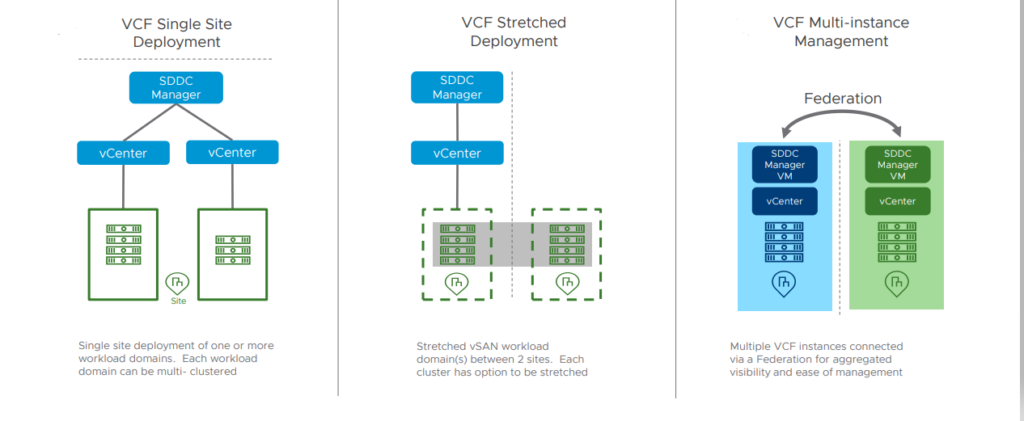The main goal of vCF is to automate the build of the software-defined data center (SDDC) and underlying components. VCF forms the basis for a true hybrid cloud environment and offers integration options with VMware Cloud on AWS/Azure, vMotion and HCX workloads can be migrated between an on-premise environment and cloud.
VCF architecture consists of a management domain and one or more workload domains. Each workload domain has its own SDDC, consisting of the components ESXi, vCenter Server, vSAN, NSX-T and vRealize suites.
vCF components are all managed by SDDC manager, a tool that does automate patching, monitoring, ILM of all components of the SDDC stack. The core advantage is that administrators spend much less time on both implementation and management tasks within an SDDC environment.
vCF thus is a fully integrated platform built on software defined services for storage, security, compute and networking
In summary, these are the tasks that can be done on vCF
- Commission Hosts: Make them ready to be used in the SDDC
- Create a Workload Domain (WLD)
- Download Bundles for update/upgrade of VCF
- Update/upgrade our SDDC to the next version of VCF
- Manage User Accounts
- Manage Passwords
- Manage Certificates
- Manage Licenses
- Manage Network Pools
- Deploy vRealize Suite components
- Enables path to hybrid Cloud
Cloud Foundation 4.2 Bill of Materials (BOM)
| Component | 4.2 | Build Number |
| SDDC Manager | 4.2.0 | 17559673 |
| vCenter Server Appliance | 7.0 Update 1C | 17327517 |
| Cloud Builder | 4.2.0 | 17559673 |
| ESXi | 7.0 Update 1d | 17551050 |
| vSAN | 7.0 Update 1D | 17551050 |
| NSX-T Data Center | 3.1.0 | 17107167 |
| VMware vRealize Suite Lifecycle Manager | 8.2 Patch 2 | 17513665 |
| vRealize Automation | 8.2 | 16980951 |
| vRealize Log Insight | 8.2 | 16957702 |
| vRealize Operations Manager | 8.2 | 16949153 |
Improvements and new addons in VCF 4.2
VMware has provided a number of new features in addition to the BOM:
- vSAN Data Persistence Platform
- NSX-T Federation
- Lockdown mode
- Static IP Pool for NSX-T TEPs
- vSAN HCI Mesh
- vSAN Includes support for inbuilt NAS support
Starting Configuration of vCF
We will need a minimum of 4 esx hosts or HCI nodes to form a VCF stack
Management Component
SDDC components are all managed by SDDC manager, a tool that does automate patching, monitoring, ILM of all components of the SDDC stack.
Everything in SDDC manager runs as a workflow, if we wish to install a VRA it runs as a workflow.
Deployment Options
vCF can be deployed as a single site, multisite or a as stretched cluster as shown

Deployment types
- Consolidated – Usually meant for Small deployments . Compute workloads co-reside in management workload domain
Minimum – 4 nodes and Maximum – 32 nodes
( Infra and Worlload VM’s on the management domain )
- Standard Architecture – Isolates management traffic from the workload domain. Up to 8 racks can be connected together. Compute workloads run in VI domain(s) and are managed by separate vCenter servers
Minimum – 8 nodes and Maximum – 256 nodes
( Management domain dedicated to Infra only and dedicated clusters for workload VM’s)
Up to 15 WLD including Management domains can be created with vCenter instances run in as linked-mode
Deployment Cluster
VCF Deploys SDDC stack into domains.
- Management Domain– Runs the management stack & runs the following components
- Workload Domain – As you work load grows, you can keep a new workload domain for every business function
Management Domain–
- Special purpose domain
- Created during Bring-up
- Minimum 4 hosts
- Built using vSAN and NSX-T
- Runs infrastructure components SDDC Manager, vCenter Server, NSX-T Manager
- Runs Optional: vRealize Operations, vRealize Log Insight, vRealize Automation
License Management
These products are deployed by SDDC are covered by VCF license
- VMware vSphere
- vSAN
- NSX-T
- vLog
These products deployed by SDDC are licensed separately
- Horizon View
- App volumes
- VRA
- vRealize Operations
- Tanzu Kubernetes


